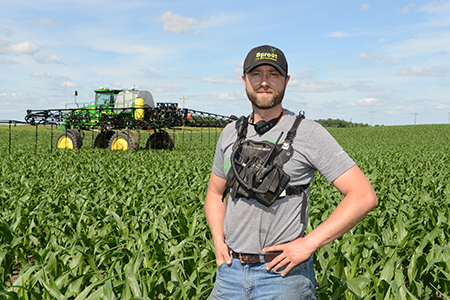This yearlong endeavor looks at how four farmers are evaluating technology and agronomic information that can boost the productivity of their operations.

Tight margins have a lot of farmers seeking ways to cut costs to make a profit. Not Ben Pederson. He looks for muscle, not fat, when he makes decisions on inputs.
"I wrestled with the idea of cutting costs by using less of this or that, but my goal is to raise more per acre than I did the year before," Pederson says. "Each year, I build on what works and fill in any weak spots. If I slash the wrong thing this season, it could take me back five seasons in that quest. For example, if I drop a biological or an insecticide that I've been using, and we have disease or insect pressure, it may take money out of my pocket. The idea is if I remove one thing that works, it could remove the ability of something else to do its job. It's the Liebig's barrel theory, and I believe in it."
Pederson is certain that breaking yield barriers is the key to long–term success. "I am confident that everything in my system has a purpose," the Lake Mills, Iowa, farmer says. "I'm not interested in sitting on the sidelines for a year in my quest to grow yields and be a better steward of my land."
"Ben is definitely ahead of the curve on aggressive investment for yield," says Kyle Shirk, BASF innovation specialist. "He and others like him are not trying to save their way to prosperity. Too many producers are worried about where to save a penny, while Ben and growers in his segment know the key is to get more bushels in a down market."
Pederson credits his introduction to strip tillage for his focus on increasing yields while improving sustainability and stewardship. Investments that have paid off through more efficient use of inputs include the purchase of a new John Deere 4830 high–clearance sprayer and Yield 360 Y–Drop, and Undercover attachments that allow just–intime and only–when–needed late–season applications of critical nutrients and fungicides.
"These investments let me sidedress less in the case of nitrogen but with more accurate and effective placement later in the season," Pederson says. "In the case of the Headline AMP application at tassel, the Undercover units will mist the plants from within the row, putting the protection where it is needed, on the ear leaf. I expect that if I can get a 4– to 5–bushel response with aerial application, the Undercover application has the potential for a 10–bushel response."
Shirk agrees coverage is king. "Protection of the ear leaf is important and should be that much more profound with ground application and the use of Undercover units. Applying Priaxor and Fastac insecticide on soybeans at R3 with Undercover misting, as Pederson has planned, should improve coverage and improve yield response there, as well," Shirk adds. ALWAYS POSITIVE . Pederson sees his inputs and activities as building blocks with synergistic value. That includes his side business called Sprout Ag Enterprises, which sells Precision Planting and 360 Yield Center technologies. These dealerships are helping shore up his income as crop margins get tight. This year, he is getting double–duty with the highboy by doing custom spraying, which also showcases the technologies offered through the dealerships and better utilizes employees.
"We invest in new technology with agronomic merit, not bells and whistles," Pederson says. "We try to make every dollar spent give us more in return. I think the custom work will help drive sales, provide profit and keep employees busy."
He also invested in dual–hybrid placement based on management zones this year. He used a combination of his own dead reckoning, yield history and soil maps to set up planting prescriptions. Keeping one planter supplied with a single hybrid and the second set up for dual hybrids added to the spring's balancing act.
"I set up job sheets for every field," Pederson says. "They covered how many pounds of seed, which seed, which side of the field to start on and in which direction, insecticide, fertilizer, variable rates and hybrids. I was in constant contact by technology with both planters, and we had a scale kit on the bulk seed cart."
Similar work orders for the support employee on the fertilizer tanker kept Pederson supplied with the right combination of products. This year, that included the use of Boost, a Midwestern BioAg product that includes molasses, potassium, sulfur and a little nitrogen.
"Judging by input costs and crop prices, I knew my budget would be in the red or close to it with average yields," he says. "I know I need above–average yields, but if I cut back on key building blocks, we could have the best growing season ever, and I'm not going to produce the best yields."